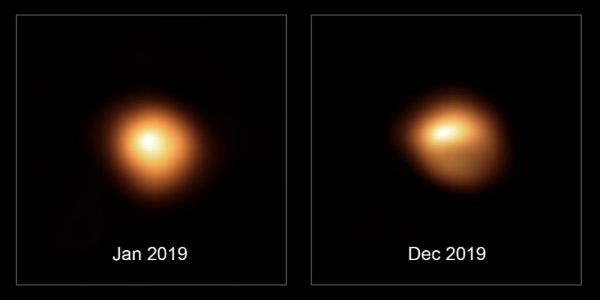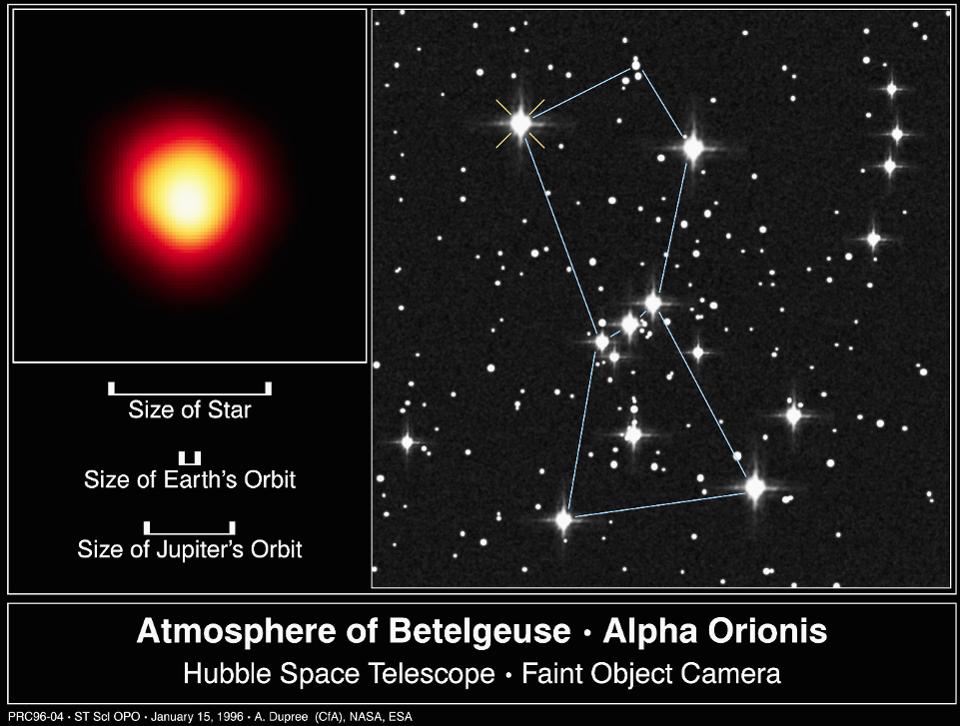Now What’s Going On With Betelgeuse? The ‘Future Supernova’ Just Isn’t That Cool, Say Astronomers – Forbes

Observations of the star Betelgeuse taken by the ESO’s Very Large Telescope in January and December … [+] 2019, which show the star’s substantial dimming.
ESO/M. Montargès et al.
Astronomers expect Betelgeuse to explode as a supernova … within the next 100,000 years, when its core collapses. However, evidence is mounting that the star’s dimming, which began in October, isn’t necessarily a sign of an imminent explosion.
A new paper accepted to Astrophysical Journal Letters and published on the preprint site arXiv entitled ‘Betelgeuse Just Isn’t That Cool: Effective Temperature Alone Cannot Explain the Recent Dimming of Betelgeuse’ by Emily Levesque, a UW associate professor of astronomy, and Philip Massey, an astronomer with Lowell Observatory, suggests that Betelgeuse isn’t dimming because it’s about to explode.
It’s just dusty.
Astronomers have been on alert since late in 2019 when Betelgeuse—found in the constellation of Orion—began to visibly dim, eventually dropping to around 40% of its usual brightness before slightly brightening in recent weeks.
Could it be about to explode as a massive supernova?
Probably not. Levesque and Massey made optical spectrophotometry observations of Betelgeuse on February 14, 2020 at Lowell Observatory in Flagstaff, Arizona, to calculate the average surface temperature of the red supergiant star. Their results indicate that Betelgeuse is significantly warmer than expected if the recent dimming were caused by a cooling of the star’s surface.
This evidence suggests that Betelgeuse has probably “sloughed off” some material from its outer layers, something that is common with red supergiant stars. “We see this all the time in red supergiants, and it’s a normal part of their life cycle,” said Levesque. “Red supergiants will occasionally shed material from their surfaces, which will condense around the star as dust. As it cools and dissipates, the dust grains will absorb some of the light heading toward us and block our view.”

The first direct image of a star other than our sun, taken with the Hubble Space Telescope. … [+] Betelgeuse is an enormous star in the constellation Orion. This ultraviolet image shows a bright spot on the star that is 2000 degrees centigrade hotter than the rest of the surface. The picture on the right shows the constellation Orion, with Betelgeuse marked by a yellow cross. The star’s size relative to the earth’s orbit is also shown. (Photo by © CORBIS/Corbis via Getty Images)
Corbis via Getty Images
How do you take a star’s temperature?
The astronomers calculated Betelgeuse’s temperature by looking at the spectrum of light emanating from it. “Emily and I had been in contact about Betelgeuse, and we both agreed that the obvious thing to do was to get a spectrum,” said Massey. “I already had observing time scheduled on the 4.3-meter Lowell Discovery Telescope, and I knew if I played around for a bit I would be able to get a good spectrum despite Betelgeuse still being one of the brightest stars in the sky.”
They looked for the telltale signs of light that had been absorbed by titanium oxide, which forms in the upper layers of large, relatively cool stars like Betelgeuse. By their calculations, Betelgeuse’s average surface temperature on February 14 was about 3,325º Celsius/6,017º Fahrenheit.
That’s only 50-100º Celsius cooler than calculated in 2004.

Orion rising behind the iconic Hoodoos on Highway 10 east of Drumheller, Alberta, near East Coulee, … [+] on a moonless January night, with illumination by starlight and by a nearby yardlight providing some shadows and warmer illumination. Clouds are beginning to move in and are providing the natural star glows. (Photo by: Alan Dyer /VW PICS/Universal Images Group via Getty Images)
Universal Images Group via Getty Images

Orion rising behind the iconic Hoodoos on Highway 10 east of Drumheller, Alberta, near East Coulee, … [+] on a moonless January night, with illumination by starlight and by a nearby yardlight providing some shadows and warmer illumination. Clouds are beginning to move in and are providing the natural star glows. (Photo by: Alan Dyer /VW PICS/Universal Images Group via Getty Images)
Universal Images Group via Getty Images
So, not much has changed—and dimming should be ruled-out. “A comparison with our 2004 spectrum showed immediately that the temperature hadn’t changed significantly,” said Massey. “We knew the answer had to be dust.” The theory is that newly formed dust is absorbing some of Betelgeuse’s light. The other possibility is that huge convection cells within Betelgeuse had drawn hot material up to its surface, where it had cooled before falling back into the interior. “A simple way to tell between these possibilities is to determine the effective surface temperature of Betelgeuse,” said Massey.
However, if you’re hoping to see Betelgeuse go supernova and shine brightly day and night for weeks or months, keep looking. “Red supergiants are very dynamic stars,” said Levesque. “The more we can learn about their normal behavior—temperature fluctuations, dust, convection cells—the better we can understand them and recognize when something truly unique, like a supernova, might happen.”
Wishing you clear skies and wide eyes.





